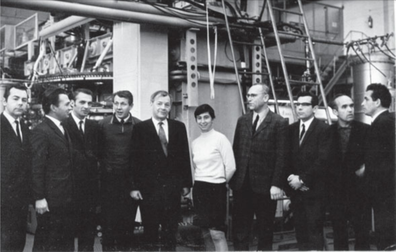Biography:Ksenia Aleksandrovna Razumova
Ksenia Razumova | |
|---|---|
| Born | 23 January 1931 |
| Nationality | Russia |
| Alma mater | Moscow University |
| Known for | Plasma, Tokamak, Nuclear Fusion, Magnetic confinement fusion |
| Scientific career | |
| Fields | Physicist |
| Institutions | Kurchatov Institute |
Ksenia Aleksandrovna Razumova (Russian: Ксения Александровна Разумова; also transliterated Xenia Razumova; born 23 January 1931) is a Russian physicist. She graduated from the Physical Faculty of Moscow University in 1955 and took a position at the then called Kurchatov Institute of Atomic Energy in Moscow, then USSR. She defended her Ph.D. in 1966, was Candidate in Physical and Mathematical sciences in 1967, and became Doctor of Sciences in 1984. She is laboratory head at the Institute of Nuclear Fusion, Russian Research Centre Kurchatov Institute. Since the beginning she is actively involved plasma physics in research on the tokamak line of Magnetic confinement fusion.[1]
Selected work
Razumova is best known for her early experimental research in the tokamak line.

Inspired by the theoretical work of Vitaly Shafranov, she developed a macroscopically stable plasma in the tokamak TM-2 in 1963.,[2] opening the way to a world-wide shift of the nuclear fusion programme towards the tokamak line.[3]
Experiments carried out by her at this tokamak, along with results obtained on the T-3 and T-4 tokamaks, convinced the scientific community that the pessimistic forecasts for the future of magnetic confinement based on the Bohm formula[4] were unfounded. In 1971, she was awarded the USSR State Prize for creating and investigating high temperature thermonuclear plasmas in tokamaks.[5] Her work contributed to the very fast development of the tokamak line in the 1970s.
Razumova was a pioneer on the study of MHD instabilities and disruptions in tokamaks.[6] In 1962, she and her colleagues were the first to observe the disruption instability in a tokamak.
Razumova was the first to implement a method to measure the plasma energy based on the diamagnetic effect, still in use these days.[7]
With V. Alikaev, she demonstrated plasma heating by Electron Cyclotron in the TM-3 tokamak. Her team also investigated runaway electrons in tokamaks.[8]
Since the mid 1980s her interest has shifted to investigation on plasma transport, in particular to the study of profile consistency and plasma self-organization.[9][10][11]
Razumova is as active now as she was in her younger years, and is always eager to discuss new ideas and experiments.
Honours and awards
- 1971 - USSR State Prize for the "Realisation and investigation of high-temperature thermonuclear plasmas in Tokamaks"
- 1974 - I.V.Kurchatov Prize
- 1983 - USSR State Prize for her contributions to "The development of high power gyrotrons and their applications in thermonuclear research"
- 1984 - I.V.Kurchatov Prize
- 1992 - L.A.Artsimovich Prize for her contributions to "The physics of heating and current drive by electron cyclotron waves"
- 2006 - Honorable Silver Badge of the Global Energy Prize
- 2017 - The Hannes Alfvén Prize of the European Physical Society in 2017[12]
References
- ↑ K.A.Razumova, personal communication
- ↑ E.P. Gorbunov and K.A. Razumova, Effect of a strong magnetic field on the magnetohydrodynamic stability of plasma and the confinement of charged particles in the 'Tokamak' machine Plasma Physics (Journal or Nuclear Energy Part C) 1964. Vol. 6, No. 5, pp. 515-525 (Translated from Atomnaya Energiya, Vol. 15, No. 5, pp. 363–369, 1963)
- ↑ Editorial 44th European Physical Society conference on Plasma Physics, Marta Fajardo and Richard Dendy Plasma Phys. Control. Fusion 60 010101 (2018)
- ↑ Bohm, D. (1949) The characteristics of electrical discharges in magnetic fields, A. Guthrie and R. K. Wakerling (eds.), New York: McGraw-Hill.
- ↑ ФИЗИКА ПЛАЗМЫ, том 27, No. 5, с. 479-480 (2001)
- ↑ N.D. Vinogradova and K.A.Razumova, Higher-mode instabilities in a Tokamak device, Plasma Physics and Controlled Nuclear Fusion Research - 1965 Proceedings of International Conference, Culham, Abingdon, 6-10 Sept. 1965) v.II, p.617
- ↑ K.A. Razumova, Measurement of plasma energy in the Tokamak device by the change in longitudinal magnetic flux, Plasma Physics Journal of Nuclear Energy Part C) 1966, Vol. 8, No. 5, pp. 791-797 (Translated from Atomnaya Energiya, Vol. 20, No. 6, pp. 459–464, 1966)
- ↑ V.V.Alikaev, Yu.I.Arsen’ev, G.A.Bobrovskii, A.A.Kondratiev, K.A.Razumova, The role of runaway electrons in developing instability in a tokamak Sov. Phys. - Tech. Phys., Vol. 20, p.322, 1975 (Translated from Zhurnal Tech. Phys., Vol.45, No.3, 1975)
- ↑ Yu V Esiptchuk and K A Razumova, Investigation of plasma confinement on Soviet tokamaks, Plasma Physics Control. Fusion, Vol. 28, No.9A, pp.1253-1261, 1986
- ↑ K.S. Dyabilin and K.A. Razumova, Interpretation of tokamak self-consistent pressure profiles, Nucl. Fusion, Vol.55, p. 053023, 2015
- ↑ K. A. Razumova Features of self-organized plasma physics in tokamaks, Plasma Phys. Control. Fusion 60 014037 (2018)
- ↑ List of Alfvén Prize Winners (from the Plasma Physics Division of the European Physical Society)
External links
 |


